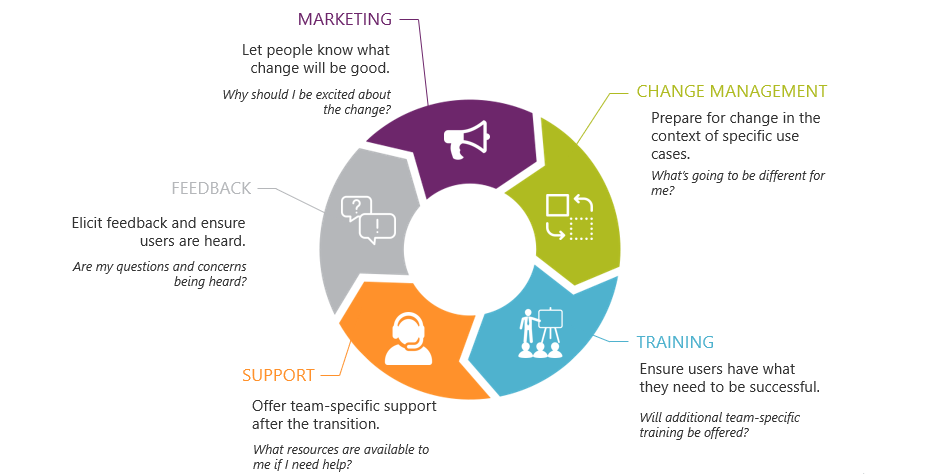The Impact of Organizational Culture on User Enablement
The Impact of Organizational Culture on User Enablement
When new technology fails to launch, it often has less to do with the technology itself and more to do with the company-wide enablement and adoption of that new solution. Despite a significant investment in leadership’s part, a strong communication campaign, and/or a robust training plan, creating a culture of change remains the biggest challenge.
Ask the following questions before diving into a new IT initiative:
- Has the culture been identified and defined?
- Is it something that everyone can easily understand and rally behind?
- Do employees and leadership feel alignment on the culture?
Well-defined work cultures adjust to technology changes best
In organizations that have a well-defined culture, it’s often easier to rally people around important changes than in organizations where this is less defined. In these instances, employees may have a better understanding of shared purpose, or there might be a stronger tie to the mission, vision and goals of the organization.
When an individual from an organization with a less transparent culture encounters a change (be it big or small), that individual might greet the change with more questions, greater resistance or outright negativity. When the culture is open, it is easier to understand the change, the decisions that went into it, and how it might impact everyone differently.
Change is adopted where there is trust
Understanding the culture of your organization can influence just about any aspect of a project. It can shape the direction of a conversation or an entire engagement.
When members of an organization have a full understanding of the collective identity, they can move through change much more easily. It’s easier to predict the impact of a change, or even how long it might take for a change to take hold.
If trust is pervasive throughout the culture, employees will be more likely to understand why leaders are requesting a change, and as a result, be less resistant to it. In short, they’ll jump on board much more easily than if there is no trust or understanding of the individual benefits of change.
Shaping a user enablement and adoption strategy
While it may be easy to say that all organizations have an open and transparent culture, that may not work for everyone.
There might be regulations or other proprietary reasons to keep things more buttoned up. And that may not be a bad thing. One shouldn’t necessarily jump to conclusions and determine then that the culture is “broken” or misaligned with the overall company goals and strategy.
When we engage with our clients, a critical step is to ask questions about the culture and try to get a feel for what it is. This can help shape the enablement and adoption strategy, as in the following examples:
In a culture with a great deal of transparency which values employee input, creating a champion program around a given change can be extremely impactful. The leaders trust the champions to spread the word and generate excitement about a change.
In an organization where the culture is less open, leadership might be hesitant to have end-user champions communicate a change – they may be fearful that a message might be skewed or that expectations may not be adequately communicated. In this case, the leaders may opt to deliver all messages themselves.
There’s no right or wrong method. In both scenarios the change gets made, just using different tactics. As consultants, it’s our job to provide the client with whatever tools best fit their individual culture to make the change as smooth as possible.
Key considerations to remember
- No two organizations are the same
It’s worthwhile to spend some time documenting the “corporate identity” of your organization and vetting it with employees. Knowing how employees “fit” into an organization is indispensable to determine how change can be implemented. - Leadership buy-in to the culture can make or break a change
Explicit leadership buy-in reduces gossip and internal politics. Great leaders shouldn’t define culture for an organization; let it grow organically from the inside out. - If a culture is more “closed”, identifying consistencies can help facilitate the change
Rather than focus on all the things that will change because of a technology or other implementation, try to put people at ease by focusing on what will stay the same. For example, the process remains the same, but the tool is different. Or a project team is changing but activities remain the same.
Pop culture examples of organizational culture impact
Movies and TV shows set in workplaces can teach us a lot about organizational culture. If you’ve ever watched The Office you’ve had a glimpse into a corporate culture gone slightly awry. Although it provided a lot of laughs, the leadership of the fictional company Dunder Mifflin did not respect employee boundaries, shared personal information of employees at inappropriate times, and rarely took employee feedback into account when making decisions.
Alternately, the TV show The West Wing inspired a culture of teamwork and productivity. It was a great example of a leader carefully considering what his team thought or proposed; sometimes he listened and acted in accordance, and sometimes he exercised his executive position to take an alternate path. But through it all, he listened.
Overcome change conflict with a user enablement and adoption plan
A strong culture promotes an open atmosphere, allowing people to be more understanding of upcoming changes; a weaker culture reinforces mistrust and rumors. For leaders, determining whether to have a culture of secrecy or sharing can make or break an investment in change.
To help overcome the conflicting forces between the need for change and the users’ inherent resistance to it, BDO Digital developed the Five Principles of User Enablement to help organizations foster a culture of continual change.
BDO Digital's Five Principles of User Enablement


SHARE